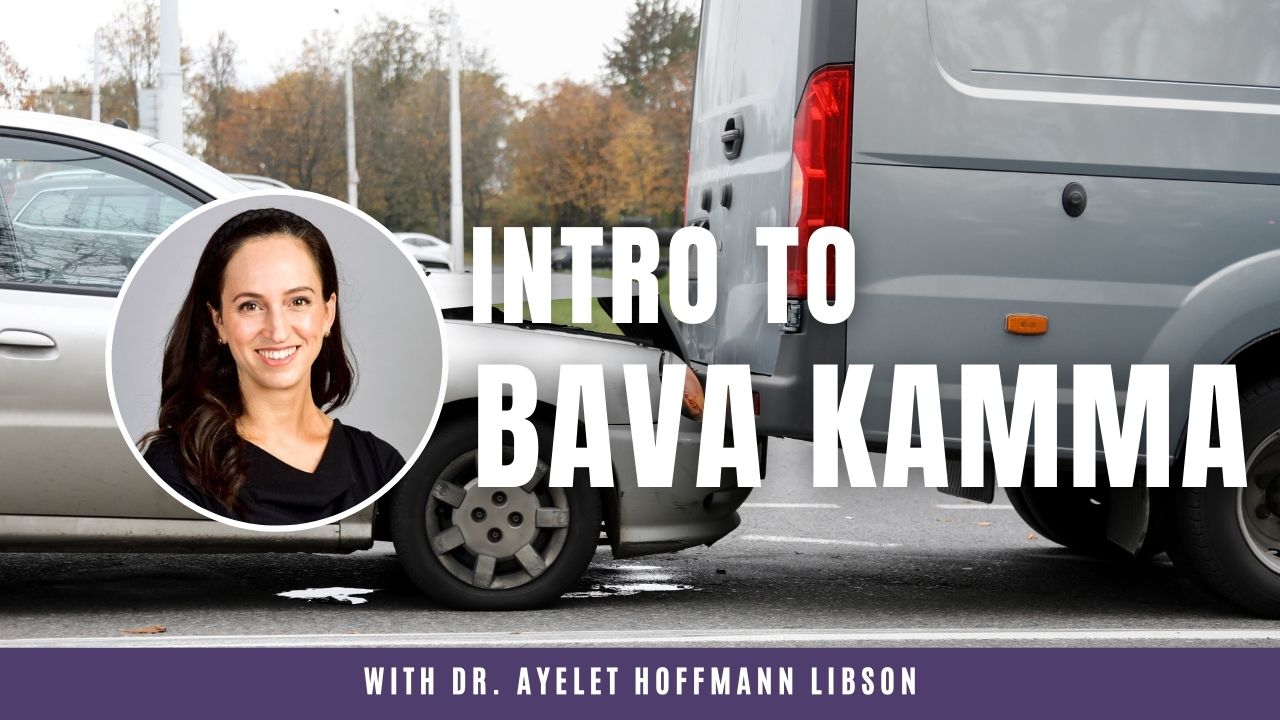Bava Kamma 2
מַתְנִי׳ אַרְבָּעָה אֲבוֹת נְזִיקִין: הַשּׁוֹר, וְהַבּוֹר, וְהַמַּבְעֶה, וְהַהֶבְעֵר.
MISHNA: There are four primary categories of damage: The category of Ox; and the category of Pit; and the category of Maveh, which, based on a discussion in the Gemara refers either to the tooth of an animal that causes damage or to a person who causes damage; and the category of Fire.
לֹא הֲרֵי הַשּׁוֹר כַּהֲרֵי הַמַּבְעֶה, וְלֹא הֲרֵי הַמַּבְעֶה כַּהֲרֵי הַשּׁוֹר; וְלֹא זֶה וָזֶה שֶׁיֵּשׁ בָּהֶן רוּחַ חַיִּים, כַּהֲרֵי הָאֵשׁ שֶׁאֵין בּוֹ רוּחַ חַיִּים;
Each of these categories is unique; therefore, the halakhot of one cannot be derived from another. The defining characteristic of the primary category of Ox is not similar to the defining characteristic of the primary category of Maveh, and the defining characteristic of the primary category of Maveh is not similar to the defining characteristic of the primary category of Ox. And the defining characteristics of this category of Ox and that category of Maveh, in which there is a living spirit that causes damage, are not similar to the defining characteristic of the category of Fire, in which there is no living spirit.
וְלֹא זֶה וָזֶה שֶׁדַּרְכָּן לֵילֵךְ וּלְהַזִּיק, כַּהֲרֵי הַבּוֹר שֶׁאֵין דַּרְכּוֹ לֵילֵךְ וּלְהַזִּיק.
The mishna continues: And the defining characteristics of this primary category of Ox and Maveh and that primary category of Fire, in which the typical manner of their components is to proceed from one place to another and cause damage, are not similar to the defining characteristic of the primary category of Pit, in which the typical manner of its components is not to proceed from one place to another and cause damage; rather, it remains in place and the damage is caused by the injured party proceeding and encountering the obstacle.
הַצַּד הַשָּׁוֶה שֶׁבָּהֶן – שֶׁדַּרְכָּן לְהַזִּיק, וּשְׁמִירָתָן עָלֶיךָ; וּכְשֶׁהִזִּיק – חָב הַמַּזִּיק לְשַׁלֵּם תַּשְׁלוּמֵי נֶזֶק, בְּמֵיטַב הָאָרֶץ.
The common denominator of the components in all of these primary categories is that it is their typical manner to cause damage, and the responsibility for their safeguarding to prevent them from causing damage is incumbent upon you, the owner of the animal or generator of the fire or the pit. And when a component of any of these categories causes damage, the owner or generator of the component that caused the damage is obligated to pay restitution for damage with best-quality land.
גְּמָ׳ מִדְּקָתָנֵי ״אָבוֹת״ – מִכְּלָל דְּאִיכָּא תּוֹלְדוֹת; תּוֹלְדוֹתֵיהֶן כַּיּוֹצֵא בָּהֶן, אוֹ לָאו כַּיּוֹצֵא בָּהֶן?
GEMARA: From the fact that the mishna teaches its ruling employing the term: Primary categories, by inference, there are subcategories of those primary categories. The Gemara asks: Are their subcategories similar to them, i.e., to their respective primary categories, so that the same halakhot apply to them, or are they dissimilar to them?
גַּבֵּי שַׁבָּת תְּנַן: אֲבוֹת מְלָאכוֹת – אַרְבָּעִים חָסֵר אַחַת. ״אָבוֹת״ – מִכְּלָל דְּאִיכָּא תּוֹלָדוֹת,
The Gemara cites additional areas of halakha where there are primary categories and subcategories and considers the relationship between them: With regard to Shabbat we learned in a mishna (Shabbat 73a): The primary categories of labor prohibited on Shabbat number forty-less-one. There too, from the fact that the mishna teaches its ruling employing the term: Primary categories, by inference, there are also subcategories.
תּוֹלְדוֹתֵיהֶן כַּיּוֹצֵא בָּהֶן; לָא שְׁנָא אָב – חַטָּאת, וְלָא שְׁנָא תּוֹלָדָה – חַטָּאת; לָא שְׁנָא אָב – סְקִילָה, וְלָא שְׁנָא תּוֹלָדָה – סְקִילָה.
With regard to the primary categories of labor prohibited on Shabbat, their subcategories are similar to them, as it is no different if one unwittingly performed labor that is a primary category, for which he is liable to bring a sin-offering, and it is no different if one unwittingly performed labor that is a subcategory, for which he is liable to bring a sin-offering. Likewise, it is no different if one intentionally performed labor that is a primary category, for which he is liable to be executed by stoning, and it is no different if one intentionally performed labor that is a subcategory, for which he is liable to be executed by stoning.
וּמַאי אִיכָּא בֵּין אָב לְתוֹלָדָה? נָפְקָא מִינַּהּ, דְּאִילּוּ עָבֵיד שְׁתֵּי אָבוֹת בַּהֲדֵי הֲדָדֵי, אִי נָמֵי שְׁתֵּי תוֹלָדוֹת בַּהֲדֵי הֲדָדֵי – מִחַיַּיב אַכׇּל חֲדָא וַחֲדָא; וְאִילּוּ עָבֵיד אָב וְתוֹלָדָה דִּידֵיהּ – לָא מִחַיַּיב אֶלָּא חֲדָא.
And what difference is there between a primary category and a subcategory? The Gemara explains: The practical difference is that if one unwittingly performs two labors classified as different primary categories together, during a single lapse of awareness, or, alternatively, if one unwittingly performs two labors classified as subcategories of two different primary categories together, during a single lapse of awareness, one is liable to bring a sin-offering for each and every labor that he performed. Each primary category of labor is an independent transgression. While if one unwittingly performs a labor that is a primary category and another labor classified as its subcategory during a single lapse of awareness, he is liable to bring only one sin-offering.
וּלְרַבִּי אֱלִיעֶזֶר – דִּמְחַיֵּיב אַתּוֹלָדָה בִּמְקוֹם אָב; אַמַּאי קָרֵי לֵיהּ אָב, וְאַמַּאי קָרֵי לַהּ תּוֹלָדָה? הָךְ דַּהֲוָה בְּמִשְׁכָּן חֲשִׁיבָא – קָרֵי לֵיהּ אָב, הָךְ דְּלָא הֲוֵי בְּמִשְׁכָּן חֲשִׁיבָא – קָרֵי לַהּ תּוֹלָדָה.
The Gemara asks: And according to Rabbi Eliezer, who deems one liable to bring two sin-offerings even if one performs a labor classified as a subcategory together with a labor that is its primary category, why is one labor characterized as a primary category and why is the other labor characterized as a subcategory? The Gemara explains: Of the labors prohibited on Shabbat, that which was a significant labor in the Tabernacle, the Sages characterized it as a primary category, and that which was not a significant labor in the Tabernacle, the Sages characterized it as a subcategory. The labors prohibited on Shabbat are derived from the labors employed in the construction of the Tabernacle; therefore, their classification is also based on their significance in its construction.
גַּבַּי טוּמְאוֹת תְּנַן: אָבוֹת הַטּוּמְאוֹת – הַשֶּׁרֶץ, וְהַשִׁכְבַת זֶרַע,
With regard to ritual impurities, we learned in the mishna (Kelim 1:1): The primary categories of ritual impurity are as follows: Any of the eight species of the creeping animal enumerated in the Torah (Leviticus 11:29–30), and semen,
וּטְמֵא מֵת. תּוֹלְדוֹתֵיהֶן לָאו כַּיּוֹצֵא בָּהֶן; דְּאִילּוּ אָב – מְטַמֵּא אָדָם וְכֵלִים, וְאִילּוּ תּוֹלָדוֹת – אוֹכָלִין וּמַשְׁקִין מְטַמֵּא, אָדָם וְכֵלִים לֹא מְטַמֵּא.
and one who is impure with impurity imparted by a human corpse. A person, a vessel, or food that is rendered impure through contact with an item classified as a primary category of ritual impurity is characterized as a subcategory. In that domain, their subcategories are dissimilar to them, as any person or item classified as a primary category of ritual impurity impurifies a person and impurifies any vessels with which it comes into contact, while a person or item classified as a subcategory of ritual impurity impurifies food or drink, but does not impurify a person or vessels.
הָכָא מַאי? אָמַר רַב פָּפָּא: יֵשׁ מֵהֶן כַּיּוֹצֵא בָּהֶן, וְיֵשׁ מֵהֶן לָאו כַּיּוֹצֵא בָּהֶן.
After determining that there are instances where the legal status of subcategories is like that of primary categories, e.g., Shabbat, and there are instances where the legal status of subcategories is dissimilar to that of primary categories, e.g., ritual impurity, the Gemara asks: Here, with regard to the laws of damages, what is the relationship between the primary categories and their subcategories? Rav Pappa said: There are, among the primary categories of damage, some whose subcategories are similar to them, and there are, among them, some whose subcategories are dissimilar to them.
תָּנוּ רַבָּנַן: שְׁלֹשָׁה אָבוֹת נֶאֶמְרוּ בְּשׁוֹר – הַקֶּרֶן, וְהַשֵּׁן, וְהָרֶגֶל.
§ Seeking to clarify Rav Pappa’s statement, the Gemara cites a baraita that delineates the primary categories of damage. The Sages taught in a baraita: Three primary categories of damage were stated in the Torah with regard to an ox. An ox causes damage in three ways, and each is classified as a distinct primary category of damage represented by a part of the body of the ox: There is the category of Goring [keren], literally, horn. This is referring to an ox goring a person or an animal and causing damage. And there is the category of Eating [shen], literally, tooth. This is referring to one’s ox causing damage by consuming another person’s produce. And there is the category of Trampling [regel], literally, foot. This is referring to an ox trampling another person’s belongings and causing damage. These are classified as primary categories because they are mentioned explicitly in the Torah.
קֶרֶן מְנָלַן? דְּתָנוּ רַבָּנַן: ״כִּי יִגַּח״ – אֵין נְגִיחָה אֶלָּא קֶרֶן, שֶׁנֶּאֱמַר: ״וַיַּעַשׂ לוֹ צִדְקִיָּה בֶן כְּנַעֲנָה קַרְנֵי בַרְזֶל, וַיֹּאמֶר: כֹּה אָמַר ה׳, בְּאֵלֶּה תְּנַגַּח אֶת אֲרָם וְגוֹ׳״. וְאוֹמֵר: ״בְּכוֹר שׁוֹרוֹ הָדָר לוֹ, וְקַרְנֵי רְאֵם קַרְנָיו, בָּהֶם עַמִּים יְנַגַּח״.
The Gemara elaborates: From where do we derive the primary category of Goring? The source is as the Sages taught in a baraita: The verse states: “And if an ox gores a man or a woman” (Exodus 21:28); and goring is performed only with a horn, as it is stated: “And Zedekiah, son of Chenaanah, made himself horns of iron, and said: So says the Lord: With these shall you gore the Arameans, until they are consumed” (I Kings 22:11). And the verse also states: “His firstborn bull, majesty is his, and his horns are the horns of the wild ox; with them he shall gore the nations” (Deuteronomy 33:17).
מַאי ״וְאוֹמֵר״? וְכִי תֵּימָא דִּבְרֵי תוֹרָה מִדִּבְרֵי קַבָּלָה לָא יָלְפִינַן, תָּא שְׁמַע: ״בְּכוֹר שׁוֹרוֹ הָדָר לוֹ״.
The Gemara interrupts its citation of the baraita and asks: What is the purpose of citing the additional verse introduced with the term: And the verse also states? The Gemara answers: And if you would say that the first verse cited is not a legitimate source as it is a verse from the Prophets, and we do not derive Torah matters from the texts of the tradition, i.e., Prophets and Writings, come and hear proof from the Torah: “His firstborn bull, majesty is his.”
וְהַאי מֵילָף הוּא?! גִּילּוּי מִילְּתָא בְּעָלְמָא הוּא, דִּנְגִיחָה בְּקֶרֶן הוּא!
The Gemara rejects the possibility that the reason a second verse was cited is that the primary category of Goring cannot be derived from a verse in the Prophets: But is this a halakhic derivation? It is a mere disclosure of the matter, that goring is performed with a horn. A verse in the Prophets can certainly serve as a source for that disclosure.
אֶלָּא מַהוּ דְּתֵימָא, כִּי פַּלֵּיג רַחֲמָנָא בֵּין תָּם לְמוּעָד – הָנֵי מִילֵּי בִּתְלוּשָׁה, אֲבָל בִּמְחוּבֶּרֶת – אֵימָא כּוּלָּהּ מוּעֶדֶת הִיא;
Rather, the reason the baraita cites a second verse is lest you say, based on the first verse, that when the Merciful One distinguishes between liability for damage caused by an innocuous ox, for which the owner is liable to pay half of the damages for the first three times that it gores, and liability for damage caused by a forewarned ox, which already gored three times and whose owner was cautioned to prevent the ox from goring, for which he is liable to pay the full damages, that statement applies only to damage caused with a detached horn, like the horn of Zedekiah described in the verse, e.g., if an animal held a detached horn in its mouth and caused damage with it; but for damage that an ox caused with a horn attached to its head, say that in all cases the legal status of the ox is that of a forewarned ox and its owner is liable to pay for all of the damage.
תָּא שְׁמַע: ״בְּכוֹר שׁוֹרוֹ הָדָר לוֹ וְגוֹ׳״.
Therefore, the baraita says: Come and hear a proof from another verse: “His firstborn bull, majesty is his, and his horns are the horns of the wild ox; with them he shall gore the nations,” where the reference is to a horn attached to the ox’s head. Evidently, when an ox gores with its own horns there is a distinction between an innocuous ox and a forewarned ox.
תּוֹלָדָה דְקֶרֶן מַאי הִיא? נְגִיפָה, נְשִׁיכָה, רְבִיצָה, וּבְעִיטָה.
The Gemara resumes its citation of the baraita: What is a subcategory of Goring? It includes any action that an ox performs with its body with the objective of inflicting damage: Pushing [negifa], biting, crouching upon items with the objective of inflicting damage, and kicking.
מַאי שְׁנָא נְגִיחָה דְּקָרֵי לַהּ אָב – דִּכְתִיב ״כִּי יִגַּח״, נְגִיפָה נָמֵי כְּתִיב ״כִּי יִגֹּף״! הַאי נְגִיפָה – נְגִיחָה הִיא. דְּתַנְיָא: פָּתַח בִּ״נְגִיפָה״ וְסִיֵּים בִּ״נְגִיחָה״, לוֹמַר לָךְ: זוֹ הִיא נְגִיפָה זוֹ הִיא נְגִיחָה.
The Gemara asks: What is different about goring that it is characterized as a primary category of damage, as it is written explicitly in the verse: “And if an ox gores a man or a woman” (Exodus 21:28); accordingly, negifa should also be characterized as a primary category, as it is written: “If one man’s ox hurts [yiggof ] the ox of another” (Exodus 21:35)? The Gemara answers: This negifa mentioned in the verse, is actually a reference to goring, as it is taught in a baraita that the verses states: “And if one man’s ox hurts [yiggof ] the ox of another…or if it is known that the ox was a goring ox in time past” (Exodus 21:35–36). The verse began its description of the case with the term negifa and it concluded with the term goring to say to you that in this context the two terms describe the same action: This action is negifa and this same action is goring.
מַאי שְׁנָא גַּבֵּי אָדָם דִּכְתִיב ״כִּי יִגַּח״, וּמַאי שְׁנָא גַּבֵּי בְּהֵמָה דִּכְתִיב ״כִּי יִגֹּף״?
The Gemara asks: If the two terms are interchangeable, what is different with regard to an ox goring a person that it is written: “And if an ox gores a man or a woman” (Exodus 21:28), and what is different with regard to an ox goring an animal that it is written: “If one man’s ox hurts [yiggof ] the ox of another” (Exodus 21:35)?
אָדָם – דְּאִית לֵיהּ מַזָּלָא, כְּתִיב ״כִּי יִגַּח״; בְּהֵמָה – דְּלֵית לַהּ מַזָּלָא, כְּתִיב ״כִּי יִגֹּף״.
The Gemara explains: With regard to a person, who has the ingenuity to defend himself and is not easily injured, it is written: “If an ox gores,” a term indicating an attack of greater force. With regard to an animal, which does not have the ingenuity to defend itself and is more easily injured, it is written: “If an ox hurts [yiggof ],” a term indicating an attack of lesser force. The term yiggof is related to the term magefa, meaning plague. The Torah employs that term with regard to the goring of an animal to indicate that when an animal is gored, regardless of the force of the blow, it will likely result in its death.
וּמִלְּתָא אַגַּב אוֹרְחֵיהּ קָא מַשְׁמַע לַן – דְּמוּעָד לְאָדָם הָוֵי מוּעָד לִבְהֵמָה וּמוּעָד לִבְהֵמָה לָא הָוֵי מוּעָד לְאָדָם.
And the Torah’s use of these terms teaches us a matter in passing: Because the effort required for the ox to gore a person to death is greater than the effort required for the ox to gore an animal to death, the halakha is that an ox that is forewarned with regard to goring a person is also forewarned with regard to an animal. But an ox that is forewarned with regard to an animal is not forewarned with regard to a person.
נְשִׁיכָה – תּוֹלָדָה דְשֵׁן הִיא! לָא; שֵׁן – יֵשׁ הֲנָאָה לְהֶזֵּיקָהּ, הָא – אֵין הֲנָאָה לְהֶזֵּיקָהּ.
The Gemara questions the classification in the baraita of biting, crouching, and kicking as subcategories of Goring: Isn’t biting a subcategory of Eating, as the animal both eats and bites with its teeth? The Gemara answers: No, in cases included in the primary category of Eating, there is pleasure for the animal in the course of its causing damage. In this case of damage caused by biting, there is no intrinsic pleasure for the animal in the course of the damage that it causes, as when the ox bites forcefully, the exclusive objective of the action is to cause damage.
רְבִיצָה וּבְעִיטָה – תּוֹלָדָה דְרֶגֶל הִיא! לָא; רֶגֶל – הֶזֵּיקָהּ מָצוּי, הָנֵי – אֵין הֶזֵּיקָן מָצוּי.
The Gemara asks: Aren’t crouching upon items and kicking items in order to damage them each a subcategory of Trampling, as the animal crouches by bending its legs and kicks with its feet? The Gemara answers: No, in cases included in the primary category of Trampling, the damage is commonplace, as it is caused in the course of the animal’s walking; in these cases of crouching and kicking, the damage is not commonplace, as animals do not typically kick or crouch upon utensils.
אֶלָּא ״תּוֹלְדוֹתֵיהֶן לָאו כַּיּוֹצֵא בָּהֶן״ דְּאָמַר רַב פָּפָּא, אַהֵיָיא?
After citing the subcategories listed in the baraita, the Gemara resumes its analysis of the statement of Rav Pappa: But with regard to the statement that Rav Pappa said: There are among them some whose subcategories are dissimilar to them, to which primary category was Rav Pappa referring?
אִילֵּימָא אַהָנֵי; מַאי שְׁנָא קֶרֶן – דְּכַוּוֹנָתוֹ לְהַזִּיק, וּמָמוֹנְךָ וּשְׁמִירָתוֹ עָלֶיךָ; הָנֵי נָמֵי – כַּוּוֹנָתָן לְהַזִּיק, וּמָמוֹנְךָ וּשְׁמִירָתָן עָלֶיךָ!
If we say that his reference was to these subcategories of Goring, what is different about Goring that defines it as a unique primary category? What is different is that the objective of the ox’s action is to cause damage, and the ox is your property, and responsibility for its safeguarding, to prevent it from causing damage, is incumbent upon you, its owner. In these subcategories of Goring, i.e., pushing [negifa], biting, crouching, and kicking, as well, the objective of the oxen’s actions is to cause damage, and the oxen are your property, and responsibility for their safeguarding, to prevent your oxen from causing damage, is incumbent upon you.
אֶלָּא תּוֹלָדָה דְקֶרֶן כְּקֶרֶן, וְכִי קָאָמַר רַב פָּפָּא – אַשֵּׁן וָרֶגֶל.
Rather, it is apparent that the status of a subcategory of Goring is like that of the primary category of Goring, and when Rav Pappa says: There are among them some whose subcategories are dissimilar to them, he was referring to Eating and Trampling.
שֵׁן וָרֶגֶל הֵיכָא כְּתִיבִי? דְּתַנְיָא: ״וְשִׁלַּח״ – זֶה הָרֶגֶל, וְכֵן הוּא אוֹמֵר: ״מְשַׁלְּחֵי רֶגֶל הַשּׁוֹר וְהַחֲמוֹר״.
The Gemara asks: Where are Eating and Trampling written in the Torah that led them to be classified as primary categories? The Gemara answers: The source is as the Sages taught in a baraita: The verse states: “If a man causes a field or vineyard to be eaten, and he sends forth his animal, and it consumed in the field of another” (Exodus 22:4). The two parts of the verse are referring to different categories: “And he sends forth,” this is a reference to the primary category of Trampling, as sending forth results in the animal trampling another’s produce and damaging it, and likewise it states: “Happy are you that sow beside all waters that send forth the feet of the ox and the donkey” (Isaiah 32:20). Clearly the term “send forth” is a reference to trampling by the feet of the animal.
״וּבִעֵר״ – זוֹ הַשֵּׁן, וְכֵן הוּא אוֹמֵר: ״כַּאֲשֶׁר יְבַעֵר
“And it consumed,” this is a reference to the primary category of Eating, and likewise it states: “And I will utterly sweep away the house of Jeroboam, as one consumes with
























